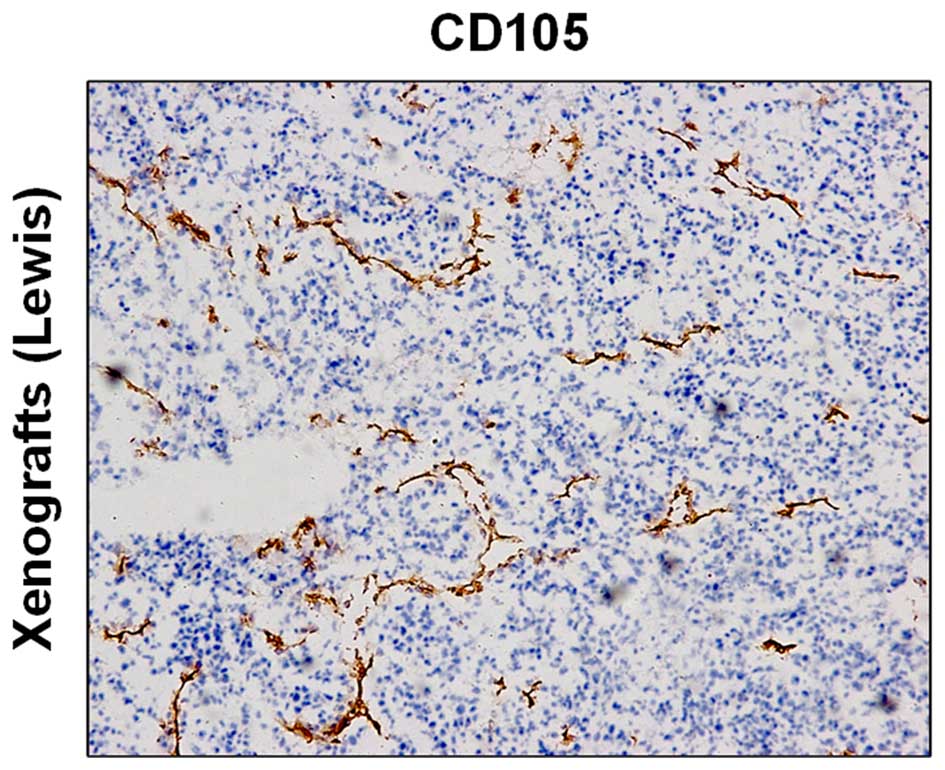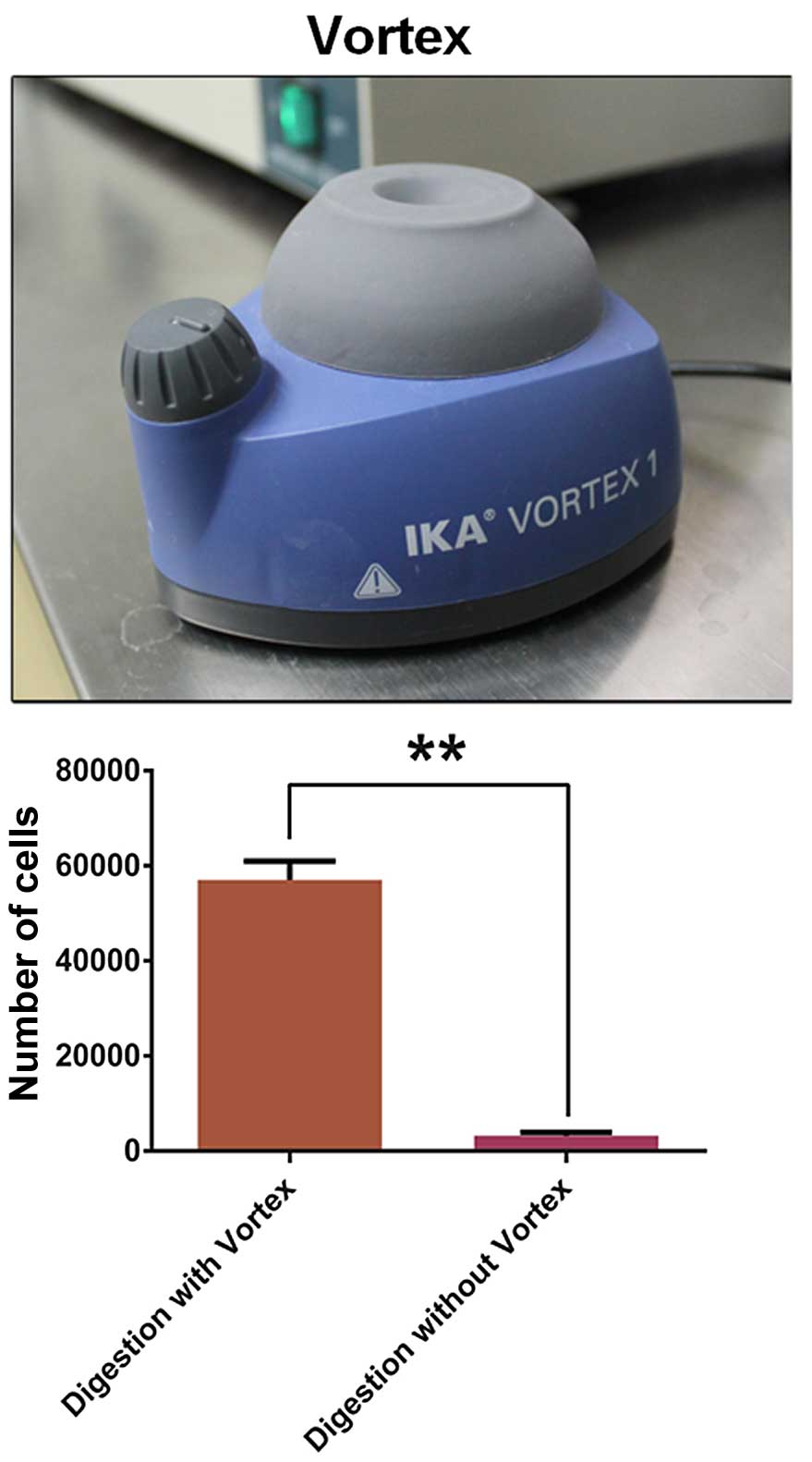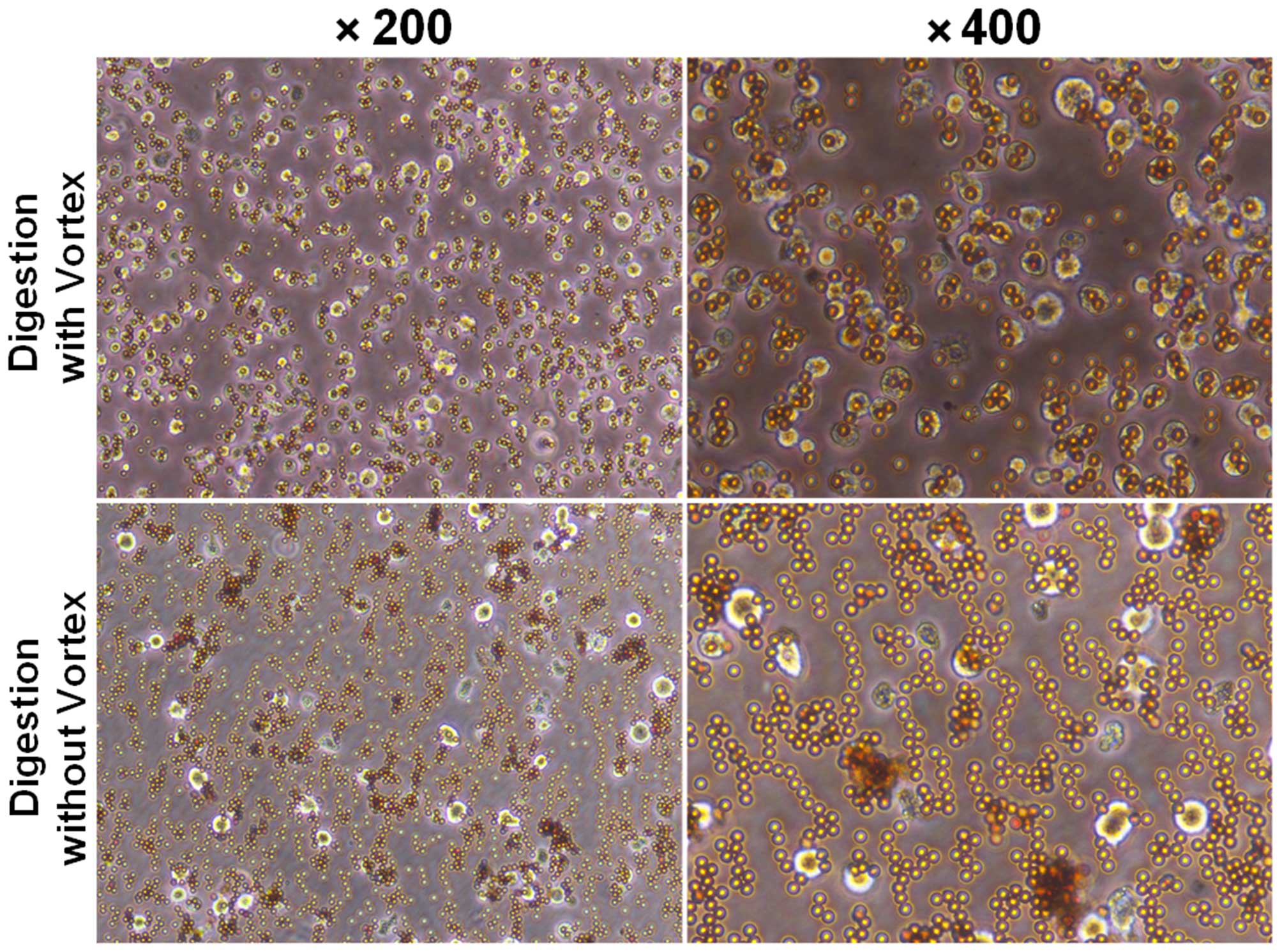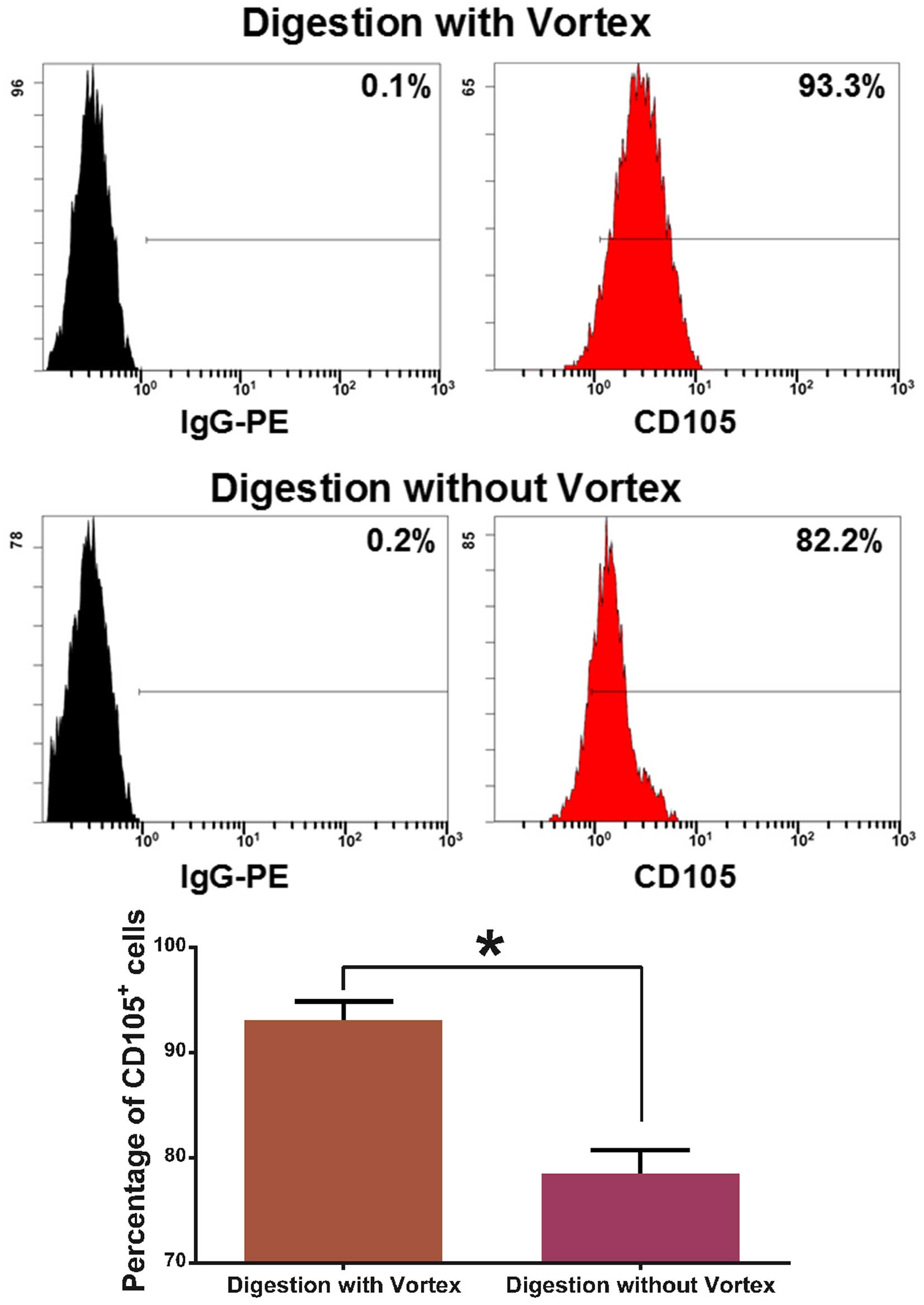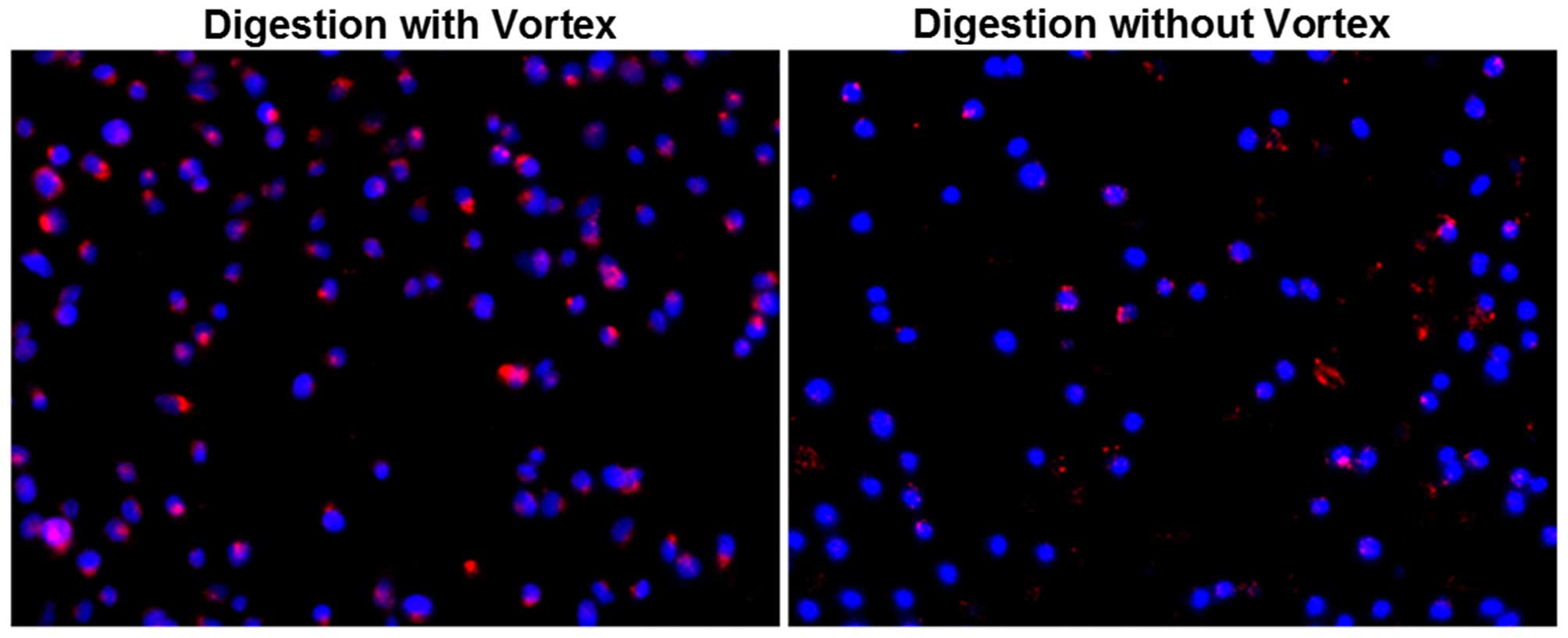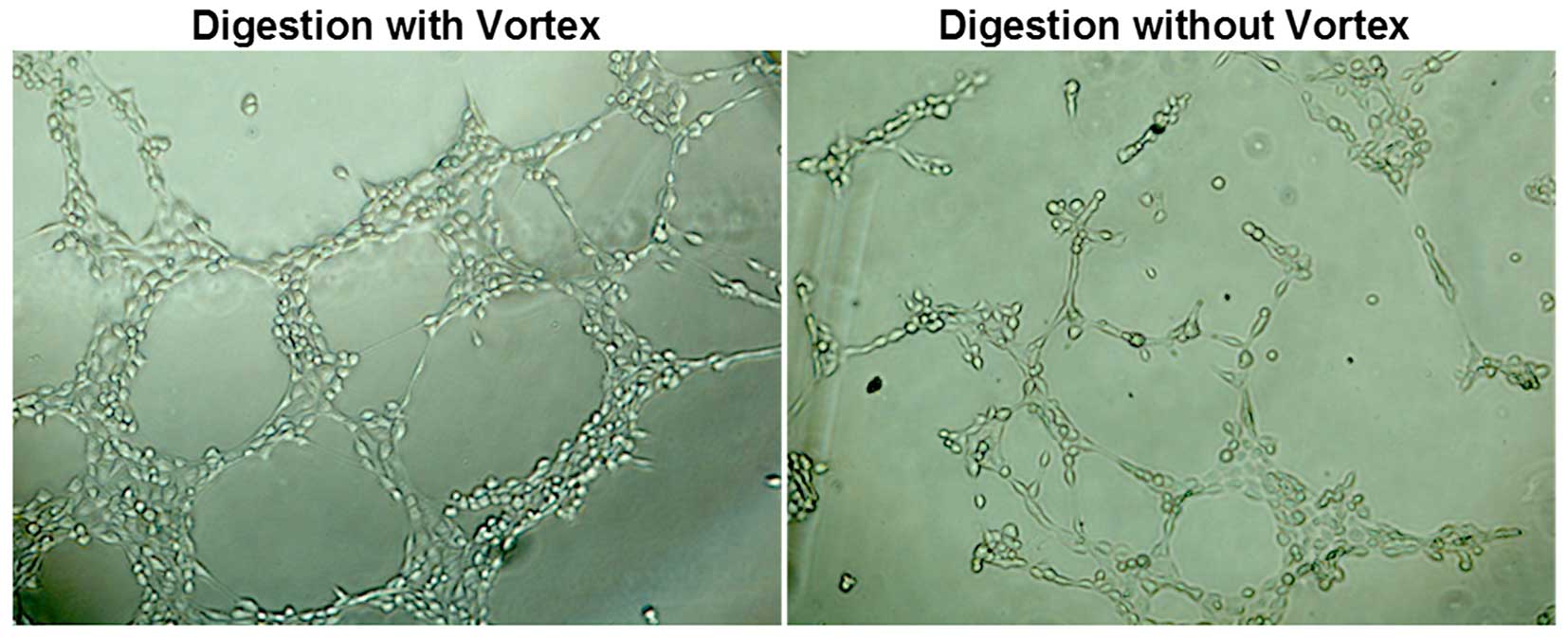A novel method for endothelial cell isolation
- Authors:
- Published online on: December 16, 2015 https://doi.org/10.3892/or.2015.4490
- Pages: 1652-1656
Abstract
Introduction
Angiogenesis plays an essential role in promoting tumor growth. Tumor development beyond 1–2 mm is dependent on the formation of a functional blood supply system for nutrient delivery (1–3). Based on previous studies involving intact established cell lines or vessels, the blood vessels of tumors and those of normal tissues differ in regards to permeability, composition of the basement membrane, extracellular matrix and cellular composition. When compared to normal blood vessels, tumor vessels are tortuous, exhibit poorly organizational characteristics, high permeability and are inclined to leak allowing macromolecules of the tumor microenvironment into blood circulation (4–6). The study of the mechanism of the development of tumor blood vessels plays a major role in tumor diagnosis and therapy. However, endothelial cells (ECs) comprise only 1–2% of the total amount of tumor tissues, and they are embedded in matrix components and tightly surrounded by various other cell types (7). Therefore, it is particularly difficult to isolate endothelial cells from tumor tissues.
In recent years, purification of ECs for culture and molecular profiling has gained more and more interest, and different techniques have been employed (8–10). However, these techniques are all prone to obtain a mixed sample with unwanted cells. This study reports a new purification method by which to obtain numerous endothelial cells in superior conditions.
Materials and methods
Cells and animals
C57BL/6 mice were obtained from Vital River Company (Beijing, China) and were housed and cared for in accordance with the Federation of European Laboratory Animal Science Association guidelines, and all protocols were approved by the Animal Ethics Committee of Guangxi Medical University (Nanning, Guangxi, China). Mouse lung carcinoma cells (Lewis) (1×106) were injected into the right flank of mice. Tumors were excised for study 45 days after injection.
Immunohistochemistry
Formalin-fixed, paraffin-embedded tissues were utilized. Dewaxed sections of Hep1–6 xenografts were blocked with 3% hydrogen peroxide and 10% normal serum from the secondary antibody species, and then incubated at 4°C with the primary antibody mCD105 (Abcam, Cambridge, UK) overnight. This was then followed by biotin labeled secondary antibody for 30 min and horseradish peroxidase-conjugated ultrastreptavidin-labeling reagent for 30 min. Color was developed with 3,3′-diaminobenzidine (DAB) solution.
Endothelial cell isolation
Tumors were removed and placed in cold PBS solution with 50 U/ml heparin. Peripheral and necrotic tissues were excised and the remaining tumor was minced using a scalpel. Dissociation of 0.1×0.1×0.1 cm3 minced tissue was performed in an enzyme cocktail of 10 mg collagenase type I, 20 ml Dulbecco's modified Eagle's medium (DMEM) and 2 ml FBS at room temperature for 60 min of constant mixing with a vortex. The cell suspension was passed through 80 mesh strainer, washed with PBS solution, and then the cells were resuspended in 100 µl buffer [PBS (pH 7.2), 0.5% FBS, 2 nM ethylenediaminetetraacetic acid]. Single cells were magnetically labeled with anti-CD105 microbeads (Miltenyi Biotec, Bergisch Gladbach, Germany) in the dark at 4°C for 30 min and applied to the prepared MS Column (Miltenyi Biotec, Bergisch Gladbach). CD105− cells were collected in the flow-through of the column, while CD105+ cells bound to the beads were flushed out by applying the plunger supplied with the column. Sorted CD105+ cells were plated into 6-well plates and cultured in endothelial cell medium (ScienCell, USA).
Fluorescence-activated cell sorting (FACS)
For flow cytometry, the cells were stained at the concentration of 1×106 cells/90 µl buffer and 10 µl phycoerythrin-conjugated anti-CD105 (eBioscience, San Diego, CA, USA) at 4°C for 25 min before FACS analysis. All data were analyzed by EXPO32 software.
Tube formation assay
To analyze the capillary-like tube formation ability of CD105+ cells, 50 µl/well of growth factor-reduced Matrigel (BD Biosciences, San Jose, CA, USA) was laid into 96-well plates to solidify. Cells were seeded into 96-well plates. After 12 h, the tube formation was assessed with microscopy.
Dil-Ac-LDL uptake assay
CD105+ cells were plated into 6-well plates at 5×104 cells/dish. At 75% confluency, the culture medium was replaced with serum-free DMEM for 24 h, followed by incubation with 2 µg/ml Dil-ac-LDL for 5 h at 37°C in 5% CO2. Then, the cells were washed and fixed with 4% paraformaldehyde at 4°C for 30 min, followed by DAPI staining for 3 min. The Dil-ac-LDL uptake was assessed using microscopy.
Statistical analysis
Data are expressed as mean ± SEM. The significance of differences between groups was assessed by a t-test. All analyses were performed with GraphPad Prism program version 5 (GraphPad Software, La Jolla, CA, USA). A P-value of <0.05 was considered to indicate a statistically significant result.
Results
CD105 expression of vascular endothelial cells in tumor tissues
Immunohistochemistry revealed high expression of CD105 in the tumor tissue (Fig. 1).
Enrichment and purity of CD105+ cells
After magnetic separation, the number of CD105+ cells digested with a vortex (5.7±0.23×104) was much more than the number without a vortex (0.32±0.04×104) (Fig. 2). After magnetic cell separation (MACS), we showed that CD105+ cells combined with microbeads as detected under a microscope (Fig. 3). The purity of the CD105+ cells was 93.07±1.7% as established by digestion with a vortex, while the purity was 78.53±2.2% as established by digestion without a vortex (Fig. 4).
Detection of CD105+ endothelial cell activity
Dil-ac-LDL uptake assay showed that CD105+ cells which were digested without a vortex exhibited red fluorescence, and CD105+ cells which were digested with a vortex exhibited stronger fluorescence (Fig. 5). Cells which were digested without a vortex and seeded onto Matrigel formed capillary-like tube structures within 12 h, while cells which were digested with a vortex formed more capillary-like tube structures (Fig. 6).
Discussion
In the process of tumor growth, tumor angiogenesis and apoptosis have emerged as important aspects. Morover, proangiogenic factors are always dominant during the process of tumor development. It is well known that during tumor angiogenesis, endothelial cells undergo cellular and molecular changes that accompany the phenotypic appearance of angiogenic vessels (11,12).
Angiogenesis is necessary for tumor growth and metastasis (13,14). CD105 is an important marker in angiogenesis but is also essential for the proliferation of endothelial cells and the stimulation of the active phase of angiogenesis (15–17).
In view of the known heterogeneity of endothelial cells, it would appear logical to study endothelial cells derived from tumor tissues when studying the mechanisms of tumor progression (18–20). Even though methods have been described for the isolation of endothelial cells, the efficiency and purity of sorting have not been described.
In the present study, we described a method to isolate endothelial cells, a rare cell population found in tumor tissue, through digestion with a vortex. The subsequent isolation of endothelial cells was achieved using anti-CD105 antibody-coated microbeads. This purification technique produces isolated cells with a purity in excess of 93%, and a higher number of CD105+ cells than that produced by digestion without a vortex. These cells express surface markers consistent with their endothelial cell origin, and maintain the ability of capillary tube-like structure formation and the uptake of acetylated LDL. This technology has a significantly important role in tumor angiogenesis research.
Acknowledgments
This study was supported, in part, by grants from the National Natural Scientific Foundation of China (nos. 81430055, 81172139, 81172138 and 81372452), the International Cooperation Project of the Ministry of Science and Technology of China (no. 2015DFA31320), the Project for Innovative Research Team in Guangxi Natural Science Foundation (2015GXNSFFA139001) and the Project of Science and Technology of Guangxi (nos. 14125008-2-12 and 1599005-2-10).
References
|
Folkman J: Tumor angiogenesis. Adv Cancer Res. 43:175–203. 1985. View Article : Google Scholar : PubMed/NCBI | |
|
Holzer TR, Fulford AD, Nedderman DM, Umberger TS, Hozak RR, Joshi A, Melemed SA, Benjamin LE, Plowman GD, Schade AE, et al: Tumor cell expression of vascular endothelial growth factor receptor 2 is an adverse prognostic factor in patients with squamous cell carcinoma of the lung. PLoS One. 8:e802922013. View Article : Google Scholar : PubMed/NCBI | |
|
Francescone R, Ngernyuang N, Yan W, Bentley B and Shao R: Tumor-derived mural-like cells coordinate with endothelial cells: Role of YKL-40 in mural cell-mediated angiogenesis. Oncogene. 33:2110–2122. 2014. View Article : Google Scholar : | |
|
Heuser LS and Miller FN: Differential macromolecular leakage from the vasculature of tumors. Cancer. 57:461–464. 1986. View Article : Google Scholar : PubMed/NCBI | |
|
Gerlowski LE and Jain RK: Microvascular permeability of normal and neoplastic tissues. Microvasc Res. 31:288–305. 1986. View Article : Google Scholar : PubMed/NCBI | |
|
Hori K, Suzuki M, Tanda S and Saito S: In vivo analysis of tumor vascularization in the rat. Jpn J Cancer Res. 81:279–288. 1990. View Article : Google Scholar : PubMed/NCBI | |
|
Griffioen AW and Molema G: Angiogenesis: Potentials for pharmacologic intervention in the treatment of cancer, cardiovascular diseases, and chronic inflammation. Pharmacol Rev. 52:237–268. 2000.PubMed/NCBI | |
|
Shi J, Wan Y, Shi S, Zi J, Guan H, Zhang Y, Zheng Z, Jia Y, Bai X, Cai W, et al: Expression, purification, and characterization of scar tissue neovasculature endothelial cell-targeted rhIL10 in Escherichia coli. Appl Biochem Biotechnol. 175:625–634. 2015. View Article : Google Scholar | |
|
Cai G, Satoh T and Hoshi H: Purification and characterization of an endothelial cell-viability maintaining factor from fetal bovine serum. Biochim Biophys Acta. 1269:13–18. 1995. View Article : Google Scholar : PubMed/NCBI | |
|
Behdani M, Zeinali S, Karimipour M, Khanahmad H, Asadzadeh N, Azadmanesh K, Seyed N, Baniahmad SF and Anbouhi MH: Expression, purification, and characterization of a diabody against the most important angiogenesis cell receptor: Vascular endothelial growth factor receptor 2. Adv Biomed Res. 1:342012. View Article : Google Scholar | |
|
van Beijnum JR, Dings RP, van der Linden E, Zwaans BM, Ramaekers FC, Mayo KH and Griffioen AW: Gene expression of tumor angiogenesis dissected: Specific targeting of colon cancer angiogenic vasculature. Blood. 108:2339–2348. 2006. View Article : Google Scholar : PubMed/NCBI | |
|
St Croix B, Rago C, Velculescu V, Traverso G, Romans KE, Montgomery E, Lal A, Riggins GJ, Lengauer C, Vogelstein B, et al: Genes expressed in human tumor endothelium. Science. 289:1197–1202. 2000. View Article : Google Scholar : PubMed/NCBI | |
|
Joshi S, Singh AR, Zulcic M and Durden DL: A macrophage-dominant PI3K isoform controls hypoxia-induced HIF1α and HIF2α stability and tumor growth, angiogenesis, and metastasis. Mol Cancer Res. 12:1520–1531. 2014. View Article : Google Scholar : PubMed/NCBI | |
|
Ostapoff KT, Awasthi N, Cenik BK, Hinz S, Dredge K, Schwarz RE and Brekken RA: PG545, an angiogenesis and heparanase inhibitor, reduces primary tumor growth and metastasis in experimental pancreatic cancer. Mol Cancer Ther. 12:1190–1201. 2013. View Article : Google Scholar : PubMed/NCBI | |
|
Nassiri F, Cusimano MD, Scheithauer BW, Rotondo F, Fazio A, Yousef GM, Syro LV, Kovacs K and Lloyd RV: Endoglin (CD105): A review of its role in angiogenesis and tumor diagnosis, progression and therapy. Anticancer Res. 31:2283–2290. 2011.PubMed/NCBI | |
|
Goumans MJ, Lebrin F and Valdimarsdottir G: Controlling the angiogenic switch: A balance between two distinct TGF-b receptor signaling pathways. Trends Cardiovasc Med. 13:301–307. 2003. View Article : Google Scholar : PubMed/NCBI | |
|
Slevin M, Krupinski J and Badimon L: Controlling the angiogenic switch in developing atherosclerotic plaques: Possible targets for therapeutic intervention. J Angiogenes Res. 1:42009. View Article : Google Scholar : PubMed/NCBI | |
|
Aird WC: Endothelial cell heterogeneity. Crit Care Med. 31(Suppl 4): S221–S230. 2003. View Article : Google Scholar : PubMed/NCBI | |
|
Lehmann I, Brylla E, Sittig D, Spanel-Borowski K and Aust G: Microvascular endothelial cells differ in their basal and tumour necrosis factor-alpha-regulated expression of adhesion molecules and cytokines. J Vasc Res. 37:408–416. 2000. View Article : Google Scholar : PubMed/NCBI | |
|
Craig LE, Spelman JP, Strandberg JD and Zink MC: Endothelial cells from diverse tissues exhibit differences in growth and morphology. Microvasc Res. 55:65–76. 1998. View Article : Google Scholar : PubMed/NCBI |



